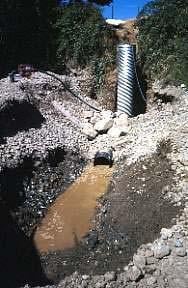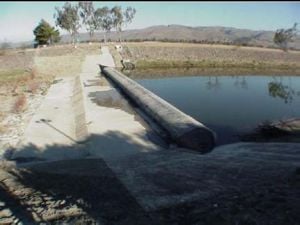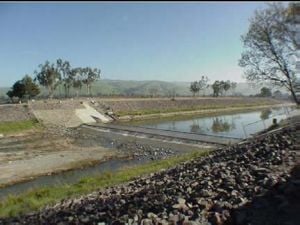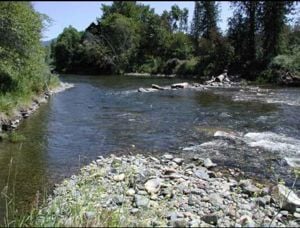Water diversion
A primary purpose of many dams, both large and small, is to facilitate water diversions. Although existing water supplies can be stretched much further and new water infrastructure can be delayed using water conservation and efficiency strategies described below, people will continue to divert water from rivers and other surface sources for various purposes.
Nearly 80 percent of water consumed in the United States comes from surface supplies—rivers, creeks and lakes. [1] In California alone, there are more than 25,000 points of diversion from streams.[2] Thus, there are at least 25,000 locations in the state at which fish and other river organisms can be harmed in the process of meeting our need for water. In many dam investigations, the question comes down to: could we still divert water if the dam is removed or modified, or not built at all? In many cases, the answer is yes. Several, more river-friendly alternatives to traditional permanent dam diversion methods are discussed below, including:
- Infiltration galleries and wells
- Screened pipe intakes
- Seasonal dams
- Consolidated diversions
Infiltration Galleries and Wells
As an alternative to a typical irrigation or smaller water supply dam, two general types of infiltration galleries have been employed to divert water from streams: vertical wells and horizontal infiltration galleries, also known as "Ranney wells."[3] Both types typically require pumps to draw water from the stream’s gravel substrate through perforated pipes, but in certain sites infiltration galleries can function by gravity alone.[4]
Vertical wells
Vertical wells draw water through perforated pipes placed vertically into the stream or floodplain substrate and water table maintained by the surface flow. Vertical wells can be located very near the stream or at some distance from the channel, depending on stream conditions. Pumps draw water up from the groundwater table.
Infiltration Galleries
Typical construction of an infiltration gallery involves placing perforated pipes in the streambed and connecting them to a collection area, or “sump” (see photo). Water seeps into the perforated pipes and flows to the sump where it is pumped out (or flows by gravity) for immediate use or storage. The size, length and depth to place the perforated pipes depends on a number of factors, including the size of the stream, rate of diversion needed, the nature of the gravel at the site and the depth to which bed scouring will occur during high flows. The perforated pipes are usually placed at least four feet deep within a bed of clean gravel at least 1.5 feet thick on all sides. The gravel, in addition to a fabric filter placed on top of the gravel layer, prevents the perforations from becoming clogged with sediment. If sedimentation is a problem, these wells can be designed with a reverse flushing feature. Depending on the site conditions and streamflow, infiltration galleries require approximately one square foot of perforated pipe surface for each gallon per minute of pumping.[5] Since 1996, the Natural Resource Conservation Service in Oregon has installed 22 infiltration galleries, some of which divert as much as 1400 gallons per minute (2.5 cubic feet per second).[6]
Advantages
Vertical wells and infiltration galleries offer a number of advantages over other diversion methods, including eliminating the impacts of dams on natural stream dynamics, avoiding the risk of fish entrainment, and reducing the visual impact of the diversion. The relatively low impact of this method can allow for diversions at any time of year.
Disadvantages
A significant challenge to infiltration galleries in certain streams is preventing the perforated pipes from becoming blocked with fine sediment. Although many infiltration galleries are equipped with a reverse pumping feature to flush out sediments, sediment can still pose problems. Caution must be taken to ensure that pumping rates do not reduce surface flows or water tables to the point of harming aquatic habitat or riparian vegetation. In addition, infiltration galleries will not work at all sites. Characteristics that could preclude the use of infiltration galleries include:[7]
- “Armored” gravels on the streambed that would indicate poor percolation rates;
- Limited thickness or absence of gravel substrate that could prevent the placement of perforated pipes at depths adequate to protect them from scouring;
- Streambed made up of fine-grained soils such as clays, silts and sands that would continually clog the perforations; and
- Stream reaches with unstable banks that can migrate significant distances from their original locations, thus separating infiltration galleries from the water source.[4]
When relying on vertical wells, there is a risk that wells could dewater the stream where the subsurface water is connected to the surface water. This is a growing problem in states, such as California, where groundwater pumping is unregulated.
Costs
The cost of infiltration galleries depends primarily on the amount of water to be diverted, which would dictate the size of the perforated pipes, amount of excavation and gravel for backfilling and the cost of pumps, if needed. Costs can range from as little as $10,000 to more than $1 million depending on project characteristics.
Where you can go for help
- For more information, contact your state natural resources agency, such as the Department of Natural Resources or Department of Environmental Protection.
- “Irrigation Alternatives Infiltration Gallery.” Oregon Department of Fish and Game, pacific.fws.gov/jobs/orojitw/technique/FishPassage/irrigation/gallery.htm.
- “Infiltration galleries of Oregon,” USDA Natural Resources Conservation Service, June 2000.
- Alternatives to Push-Up Dams (video), U.S. Bureau of Reclamation, Oregon Department of Environmental Quality, et al.

Case Study, Infiltration Galleries and Wells
In 1998, U.S. Fish and Wildlife Service and the Illinois Valley Soil and Conservation District partnered to address the problems caused by a seasonal gravel diversion dam on Sucker Creek, a tributary to the east fork of the Illinois River, in Josephine County, Oregon. This irrigation dam, and others like it, block spawning habitat for salmon and trout, and increase water temperatures, sediment loads and turbidity in the creek or stream. To eliminate the problems and preserve the irrigation diversion for the landowner, an infiltration gallery was installed for $27,667. In addition to improving water quality, access to habitat was improved for coho salmon, fall Chinook salmon and steelhead.
To learn more about the Sucker Creek irrigation project see U.S. Fish and Wildlife Service, Oregon office, http://pacific.fws.gov/jobs/orojitw/project/josephine/26-9502.htm.
Screened Pipe Intakes
Pumping water through pipes placed in rivers is a common diversion method today, but in many cases the pipe is used in conjunction with a dam – and often it is not screened to prevent fish from being entrained. When properly screened, screened pipe intakes can safely divert water to a distribution system for immediate use or into a surface or subsurface storage site away from the stream for later use. In cases where sufficient water depth consistently occurs, dams can be removed without affecting the diversion. Where sufficient depth does not occur, “vaults” can be constructed to create enough depth to allow for screened pipe diversion. These “screened vault intakes” consist of a screened pipe placed in a pre-cast concrete vault set into the stream below the streambed elevation. The vaults are often located in a natural or constructed alcove at the edge of a stream to protect the structure from scouring and deposition. Even well protected vaults must be cleared of sediment and other debris on occasion. In addition, pipe diversions behind dams could be extended upstream to allow gravity to drive the diversion if possible, thereby allowing the removal of the dam.
Advantages
The primary advantage of screened pipe intakes is that in many cases they can function without a dam or other structure to control water levels. Thus, sediment and fish can pass without significant disruption, and flows are affected only by the amount of water diverted. When combined with off-stream storage of some kind, screened pipe intakes can provide water diversions and storage functions with minimal stream impacts.
Disadvantages
One concern with pipe intakes is fish entrainment. Intake screen technology has improved greatly in recent years, but entrainment continues to be a problem in certain cases. Another concern is that screens can be expensive to install and maintain. The chief limitation, however, to applying this strategy is that in certain streams, flows might not be sufficient to reliably pump water directly from the river during the diversion season(s). This problem could be minimized if pumping took place during higher flow periods and the water was stored offstream, or if a natural pool can be safely utilized. Another drawback in certain cases where a dam is removed and the water level at the diversion point is lowered is that diverters may incur the cost of installing and operating pumps to make up for the lost water surface elevation. The Idaho Department of Fish and Game has monitored numerous screening projects and found costs range from $2,200 to $6,400 per each cubic foot per second (cfs) the intake will divert.[8] Large diversions that involve sensitive fish species can be even more expensive. For example, the U.S. Bureau of Reclamation has completed a complex screen system on the Klamath River in Oregon to prevent endangered sucker fish from entering their 1000 cfs diversion canal.[9] The system cost $16 million to construct, which represents approximately $16,000 per cfs diverted.
Case Study, Screened Pipe Intake
Foots Creek Dam on Foots Creek, a tributary to the Rogue River in Oregon, was a 5-foot high, 40-foot wide concrete dam that blocks passage for coho salmon and steelhead. A denil fish ladder installed in 1998 by the Oregon Department of Fish and Wildlife proved ineffective in providing consistent fish passage. Originally built for irrigation and recreational uses, water was being pumped from the impoundment to a pond that was used for fire protection and recreation. In 2000, the Rogue Basin Coordinating Committee (RBCC) began working with the landowner on a solution that would provide fish passage and still allow for the diversion rights. In order to meet their goal of continued water supply and adequate fish passage, RBCC and the landowner agreed on a plan that called for the removal of the dam and installation of a screened intake pipe that would continue to divert the necessary water to the nearby pond. The project was completed in 2001 with the breaching of the dam ($2,600) and installation of pump and pipe ($4,000). By removing this structure and using a screened intake pipe system to continue to supply water to the pond, six additional stream miles on Foots Creek are now open for migrating salmonids.[10] To learn more about the Foots Creek project contact Chuck Korson with the U.S. Bureau of Reclamation at (541) 389-6541 or visit http://www.pn.usbr.gov/project/wat/publications/footscreek.pdf.
Case Study, Screened Pipe Intake
The Doug James Diversion Rehabilitation project in Oregon’s Illinois River valley replaced a gravel “push-up”[11] diversion dam with a screened intake vault and associated works for $32,500 in 1998. After five years the irrigator continues to be satisfied with the effectiveness of the new structure. For more information, contact Glenn Ginter, Illinois Valley Watershed Council Coordinator, (541) 592-3731.
Where you can go for help
- For more information, contact your state natural resources agency, such as the Department of Natural Resources or Department of Environmental Protection.
- Alternatives to Push-Up Dams (video), U.S. Bureau of Reclamation, Oregon Department of Environmental Quality, et al.
- “Fish Screening Criteria for Anadromous Salmonids,” National Marine Fisheries Service, http://swr.ucsd.edu/hcd/fishscrn.htm.
Seasonal Dams
Seasonal dams are temporary structures that can be erected to store water for immediate or later diversion, or removed to allow flows and (in most cases) fish to pass. Inflatable dams and flashboard dams (also known as stop log dams) are the most common types of seasonal dams. When in operation, both types of dams raise the river level allowing water to be diverted through a channel or pipe.

Inflatable dams
Inflatable dams are made of thick, laminated rubber and nylon tubes that are anchored to a concrete foundation across the streambed. The tube can be filled automatically or manually with air or water to create a barrier, and subsequently deflated to lie flat on the foundation (see photo). The inflatable tubes usually last between 25 and 50 years.
Flashboard dams
Flashboard dams usually involve a concrete foundation and frame into which boards are inserted to block the stream flow and raise the water level to allow for diversion.

Advantages
Seasonal dams provide the flexibility to store and divert water or allow water, sediment and fish to pass when the dam is not in use. In certain cases, pools created by temporary dams can provide cool water habitat for species to over-summer in warm streams.[12] Seasonal dams are usually designed to deliver water by gravity, thus avoiding costs associated with pumping.
Disadvantages
Despite the flexibility of seasonal dams, they can cause significant problems for fish populations. For example, a dam operator might need to block the flow when fish are migrating to or from the ocean, thus delaying or entirely stopping their up or downstream movement. In addition, seasonal dams can block juvenile or adult fish from moving to cold-water refuges that help them survive high summer temperatures.[13] In some cases, the concrete structure that anchors flashboards or inflatable tubes can create barriers to fish passage even when the dam is not in operation, if scouring below the structures lowers the streambed elevation significantly, or if the water flowing over the foundation or tube is too shallow or too fast. These foundations inhibit the dynamic nature of the river, interfering with natural stream migration. This can modify sediment transport processes and cause problems with excessive scour or undesirable deposition. In addition, the pipe or channel diverting water from the temporary pool can entrain fish if not properly screened. Seasonal dams can affect streams negatively in other ways as well, including increasing water temperatures, harboring predator species, eliminating water flows and associated aquatic habitat downstream and inducing erosion of the bed and banks of streams and introducing major fluctuations in water levels upstream of the dam impacting biota, aquatic vegetation and riparian homeowners. In recent years, operators have experimented with strategies to change the shape of the tubes used in inflatable dams to improve downstream passage while the tube is inflated. The most common strategy is to create a notch or to place a strap over the tube so that it cannot fully inflate at that location. These notches increase flow depth over the tube, which is safer and more appealing to out-migrating juveniles. These notches can sometimes also be used for adults migrating upstream if the jump is not too high.
Costs
The cost of inflatable and flashboard dams depends on many factors, including the size of the stream to be impounded, channel shape and material and the complexity of the required design. In 1989, the Alameda County Water District in California constructed a 300-foot long 13-foot tall air filled inflatable dam on Alameda Creek. The concrete foundation cost $1.6 million and the bladder cost $1.6 million.[14]
Case Study, Seasonal Dams
The Susquehanna River in Pennsylvania is home to the Adam T. Bower Dam (popularly referred to as Sunbury Dam), which is the world’s largest inflatable dam. Shikellamy State Park maintains the dam, inflating it with air each spring and deflating it each fall in order to create a seasonal three-thousand-acre compound called Lake Augusta. The lake, which is approximately eight feet deep at the dam, provides 13 miles for recreation such as boating and water skiing. The rubber bags measure twelve millimeters thick and sit flat upon cement casings when not in use. This dam exemplifies in many ways, however, how inflatable dams can be misused. For example, during the 2003 season this dam was inflated in April to accommodate recreational and commercial interests and remained inflated until early fall, effectively blocking the Susquehanna during the entire migratory season (April – July) for American shad. Because of the pressures to inflate the dam early in the year, the state has agreed to let the dam operator meet migratory fish passage obligations through the construction of a fish ladder. The dam is currently providing no fish passage and has not provided any since its installation even though an inflatable dam was chosen over a more permanent structure entirely for the purpose of providing for fish passage. To learn more about the Adam T. Bower Dam, visit http://www.visitcentralpa.org/OUTDOORS/Fabridam.htm.
Where you can go for help
- For more information, contact your state natural resources agency, such as the Department of Natural Resources or Department of Environmental Protection.
- “Rubber Dam Hydraulics: Hydraulic Design of Inflatable Flexible Membrane Dams.” University of Queensland, Australia, http://www.uq.edu.au/~e2hchans/rubber.html

Consolidated Diversions
It is not uncommon for diverters to locate several diversion dams close together on a single stream. In certain cases, it is possible to consolidate the number of diversions to a single diversion point, allowing the elimination of some of the dams.
Advantages
Consolidating diversion points has the benefit of eliminating some or all of the diversion dams involved, and typically reduces the number of diversions that require screens to prevent fish entrainment.
Disadvantages
One potential drawback of this option is the need to relocate diversion pipes or canals to the new diversion point. Depending on circumstances, this could involve moving water over greater distances, require more materials, or an increase in pumping costs. It could also require some amount of cooperation or coordination among the diverters located together. Also, by consolidating multiple locations into a single diversion point, this diversion point may still create a barrier to migrating fish. While impacts on the stream will be less with fewer dams, there may still be negative impacts.
Costs
The costs of consolidating diversion points will vary greatly depending on distances between existing diversions, the size of diversions and the size and number of existing dams that would be removed. Costs can range from thousands to millions of dollars
Case Study, Consolidated Diversions
In the Touchet River basin near Walla Walla, Washington, a project to construct a fish screen, fish ladder and consolidate four irrigation diversions totaling 13 cfs that utilize three dams is expected to cost $883,000. The species that will benefit include steelhead, bull trout, whitefish and several species of native sculpin and minnow. The Upper Salmon River Diversion Consolidation Program cost $2.28 million to consolidate four diversion points totaling 15 cfs by removing three dams and consolidating diversions to a single location and screening the remaining 10 diversions. [15]
To learn more about these projects, contact the U.S. Fish and Wildlife Service in Portland, OR at (503) 872-2763
References
- ↑ U.S. Geological Survey. Water use in the United States in 1995. Washington, D.C.: GPO, 1998.
- ↑ Scott McFarland, California State Water Resources Control Board, personal communication, 15 November 2001.
- ↑ Alternatives to Push-Up Dams. Produced by the Bureau of Reclamation, Pacific Northwest Region. 10 min. 1999. Videocassette.
- ↑ 4.0 4.1 Glenn Ginter, Illinois Valley Soil and Water Conservation District, personal communication, 9 October 2001.
- ↑ Department of Agriculture, Natural Resource Conservation District. Infiltration galleries of Oregon. Washington, D.C.: GPO, 2000.
- ↑ Greg Card, Natural Resource Conservation Service, personal communication, 17 October 2001.
- ↑ Department of Agriculture, Natural Resource Conservation District. Infiltration galleries of Oregon. Washington, D.C.: GPO, 2000.
- ↑ Idaho Fish and Game, Fish Screen Program, http://www.salmonidaho.com/screenshop/ (1 December 2002).
- ↑ Bureau of Reclamation, A-Canal Fish Screen Project, http://www.mp.usbr.gov/kbao/fish_screen/ (1 December 2002).
- ↑ Bureau of Reclamation, Partnerships in Watershed Restoration: Foots Creek Fish Passage Improvement, March 2001, http://www.pn.usbr.gov/project/wat/publications/footscreek.pdf (9 June 2002).
- ↑ Gravel “push-up” dams are temporary dams that are formed by pushing up stream gravels with a bulldozer to form a dam.
- ↑ Marty Gingras, California Department of Fish and Game, personal communication, 31 October 2001.
- ↑ NOAA Fisheries and California Department of Fish & Game has increasingly denied requests for permits to operate seasonal dams, in part because they can prevent juveniles from accessing cold-water areas.
- ↑ Steve Peterson, Alameda County Water District, personal communication, 13 December 2002.
- ↑ Bonneville Power Authority, Ongoing BPA Project Summary: Upper Salmon River Diversion Consolidation Program, 24 July 1997, http://www.efw.bpa.gov/Environment/EW/PROPOSALS/AIWP/1998/9600700.pdf (3 January 2003).